Kenji Yanagiya
Warrant Officer Kenji Yanagiya (柳谷 謙治, Yanagiya Kenji, March 1919 – February 29, 2008) was a member of the Imperial Japanese Navy's Zero fighter aces who fought the Battle of Solomon Islands in October 1942 – June 1943. He is best known as the only escort fighter pilot of the Yamamoto mission to survive the war.
Kenji Yanagiya | |
|---|---|
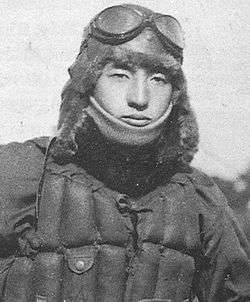 Kenji Yanagiya at Rabaul | |
| Native name | 柳谷 謙治 |
| Born | March 1919 Hokkaidō, Japan |
| Died | February 29, 2008 (aged 88) Tokyo, Japan |
| Allegiance | |
| Service/ | |
| Years of service | 1940–1945 |
| Rank | Warrant Officer |
| Unit | Kisarazu Naval Air Force, the 6th Naval Air Group, the 204th Naval Air Group |
| Battles/wars | World War II |
Biography
Born on Hokkaidō, he moved with his family at his age of two and grew up at Tomarioru prairie in Karafuto (Sakhalin). He enlisted in the Imperial Japanese Navy (IJN) at January 10, 1940 as an aircraft mechanic, then selected as a Hei-shu Hiko Yoka Renshu Sei (C-class Flight Reserve Trainee), a course was for seamen and naval non-commissioned officers already in the navy. He completed his pilot training course in March 1942. He then became a Flyer / 1st Class fighter pilot of 6th Kokutai at Kisarazu Air Base. Yanagiya arrived at Rabaul on October 7, 1942 as a member of 6th Kokutai, which was under the command of the 26th Air Flotilla in South East Division Air Fleet (including the 11th Air Fleet). The group would eventually be renamed to the 204th Kokutai the following month. He was one of the escort fighter pilots of the Fleet Admiral Yamamoto's visit to Ballale Base on April 18, 1943. After Yamamoto's death, he was injured and lost his right hand on a subsequent mission to Russell Islands, near Guadalcanal, in June 1943, which subsequently caused him to be sent back to the home islands for treatment and recovery.
Yanagiya’s Reminiscences about April 18, 1943
"Fall in!" "At ease."
"We had an outline of our escort mission in the briefing from Lieutenant (JG) Morisaki, 24 years old Midway Sōryū veteran, at East airfield (Lakunai airfield), Rabaul. Both G4M1s "Type 1 land-based attack aircraft" of Imperial Japanese Navy Grand Fleet Admiral Yamamoto's and that of Chief of staff's (IJN Grand Fleet Chief of staff Matome Ugaki's) were to take off from West airfield, Rabaul."
| Shotai | Leader | Wingman | Wingman |
|---|---|---|---|
| 1st Shotai | Lt(JG). T.Morisaki | PO 1/C T.Tsujinoue | F 1/C S.Sugita |
| 2nd Shotai | CPO Y.Hidaka | PO 2/C Y.Okazaki | F 1/C K.Yanagiya |
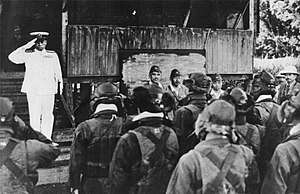
In the wartime Rabaul, there was East airfield (Lakunai airfield) by the seashore on the east side of Simpson Harbor, and West airfield (Vunakanau airfield) on the west side high hilltop of the Simpson Harbor. East airfield was for fighter units, while West airfield was for twin-engine land-based attacker units, single-engine carrier-based dive-bomber units and torpedo-attacker units.
"0600 hours Japan Standard Time (JST), we six Zero fighters took off East airfield and were waiting at a pre-briefed rendezvous point over Simpson Harbor. Those two Type 1 land-based attackers (Rikko) were taking off West airfield and coming up to us. Two Type 1 land-based attackers flew at altitude 2,500 m (8,200 ft), we six escort fighters flew at altitude 3,000 m (about 10,000 feet), which was plus 500 m higher to cover them, to intercept Allied fighters."
"These two Type 1 land-based attackers flew in echelon, and six Zero fighters flew on their starboard side aft high in two vics formations. I've heard that the Imperial Japanese Navy official action report of the day reported we Zero fighters escorted in both starboard side and port side aft of those two attackers to escort, but the fact is that we were escorting them on their 4 o'clock high. It was a fine weather day, no squalls nor cumulus clouds, comfortable for flying. We kept looking around the south air over the sea. We could see underneath transport ships with escort destroyers steaming on a blue water several times."
"After a while, we could see Bougainville Island on ahead of us. We followed to those land-based attackers within certain distance. Before long two Type 1 land-based attackers flew over Bougainville Island and we escort fighters followed. On ahead of us, we could saw IJN Buin air base, which was at the southeast end of Bougainville Island. The base looked like a brown colored small box of matches in a green sea of jungle to me. Buin base was known as a dusty airfield and always looked dry soil colored. I heard later some ground member muttered that base members had sprayed water to the airstrip in the morning and had been waiting for GF Admiral's arrival at Buin base. I thought then that was why it looked dark colored."
They were flying on schedule to land at IJN Ballale Island airstrip on 0745 hours JST.[1]
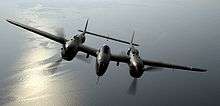
"Some 10 minutes passed and it was time when we would start approaching to the airstrip. Then we found many airborne aircraft in the direction over Shortland Island, south of Buin base. At altitude about 1,500 m (5,000 ft), they were in groups of P-38s. Their fuselages and wings were painted in green, they positioned at lower altitude, which helped them camouflaged. It was obvious that we were late to find them. I saw P-38s dropped their extra fuel tanks and were already zooming up to engage our two land-base attackers."
"Lieutenant (JG) Morisaki, waggling his wings to signal, dived to cover the GF Admiral's land-based attacker. We wingmen all accelerated and swooped into the first group of P-38s approaching our attackers. We repelled the first group of P-38s, while another P-38s engaging aft the land-based attackers. They P-38s avoided to engage us, focused their targets just on our two land-based attackers. There were only 6 fighters for us to defend that we could not cover our two attackers from them all. They were too many. I've heard that there were sixteen P-38s that day. When I recovered and turned back, I saw one land-based attacker going down in my port side with smoke and another land-based attacker going down in my starboard side to the sea. And the more, I watched the land-based attacker crash landing and disappeared in a jungle, with a little fire and smoke coming up. I also watched another land-based attacker water landing on the sea with splash. I was afraid that an extremely serious incident happened. I rushed to Buin base, shot burst over the base to alert an emergency. Two fighters were scrambling and coming up to us but all enemies were already evading in high speed."
Fighter pilots at IJN Buin Air Base hadn't been informed anything about the visit of GF Admiral Yamamoto except high-ranking officials, some IJNAS veterans noticed that it was a very unusual morning because Allied P-38s came close to and run away from Buin Base in high-speed 'again and again' at 0525, 0620 and 0700 hours JST.[2]
"I felt full of regret, I swore the revenge to them immediately. I flew to south east alone. Imperial Japanese Navy's Zero fighter had very long range of 1,929 mi (1,675 nm, 3,105 km) with external tank to fly over the sea. I knew their home base were in Guadalcanal, I expected the returning P-38s might fly in a cruising speed at low altitude to save gas. I got my chance, I soon caught one P-38 flew on the way back in low speed at altitude 3,500 m (12,000 ft) over Kolombangara island. He didn't notice me. I climbed up my Zero plus 1,000 m (3,300 ft) higher over him and swooped down to give exact bursts. My shells and rounds all hit that P-38. The P-38 went down to the sea with his fuel trailing in heavy white smoke like a long tail. I claimed the P-38 shot down because he was seriously damaged and couldn't go back to his base. I turned my Zero back and landed at Buin base. PO 2/C Yasushi Okazaki had engine troubled and had already landed at Ballale Island airstrip, neighboring Buin base. I've heard that the US official record confirmed that two Japanese Zeros were shot down that day, but it is not the fact. Okazaki fixed his Zero's engine trouble there and returned to Rabaul the next day."
F 1/C Yanagiya got off his Zero and lined to his colleagues. Buin air base was in serious. The base members asked him what the last situations were. He couldn't help answering ambiguously.
Soon came an officer and noted to him, "This incident would influence to all Navy operations. Keep it the top secret."
The airborne leader of the day, Lieutenant (JG) Takeshi Morisaki would keep reporting to the cadre at Buin base, didn't come out from the commanding post. Buin's airstrip, known as a dusty airfield, was so clear and still that day that made Buin base pathetic. Yanagiya saw several aircraft flew and kept searching over the jungle and the sea.
Soon back was Lieutenant (JG) Morisaki with his face pale. He said disappointedly, "Let's come back to Rabaul." Yanagiya and his colleagues were to fly back with their Zeros. Five escort fighters took off the airstrip and regrouped over Buin airbase. It was about noon. They took the direction in northwest and headed for Rabaul. The weather was fine and the sky was blue. They arrived Rabaul at 1350 JST.
Leader of the squadron, Lieutenant Zenjiro Miyano was waiting them sadly. Lt Miyano had offered the escort mission not with six but with twenty Zero fighters from his unit, but his offering had been rejected by Lieutenant Commander Ryoji Nomura, South East Division Fleet Air Commander Staff of Rabaul, on the day before.[3] Lt Miyano led Lt (JG) Morisaki into the 204th Air Group commanding post at East airfield. The 204th Air Group commander Captain Ushie Sugimoto were waiting for them. Yanagiya lined with his colleagues outside of the commanding post and waiting. The debriefing took long time while they four pilots kept standing outside under the tropical hot sunshine. They were called into the commanding post after Lt (JG) Morisaki's reporting was over.
The 204th Air Group Commander, Captain Sugimoto told them strictly, "This incident was very sorry. It would influence to the Japan's future. You must not speak of it."
When those escort fighter pilots returned to the ready room, their friends asked what had happened, because they escort fighters came back without those two Type 1 land-base attackers. Since their friends all watched them lined so long time outside the commanding post, then told something from their commander Captain Sugimoto. So questioned what had happened to IJN GF Admiral's land-based attack bomber, IJN GF Chief of staff's land-based attack bomber, and the Okazaki's Zero. Yanagiya answered, "A light accident happened and Admiral's aircraft and Chief of staff's aircraft made emergency landings. They were not so seriously troubled."
The unit members were all in silence. His friends then realized what had happened. It was fine all that day. Those aircraft had been well maintained. Skilled aviators had flown them. There should be something more serious happened than a light accident.
The Six Escort Fighter Pilots after the Incident
Yanagiya and his fellow pilots were neither accused nor criticized. Yanagiya was promoted to Petty Officer 2nd Class on May 1 as scheduled previously. The 204th Air Group commander and his staff officers knew that it was hard to save two Type 1 Land based attackers from sixteen Allied fighters engaging with only six escort fighters. The six pilots, however, thought themselves responsible for the incident so seriously that they charged themselves to shoot down as many Allied airplanes as possible.
On June 7, 1943, the 204th Air Group at Buin base planned an operation to bomb Allied Russell Islands airfield with 81 fighters. Twelve Zeros, armed with firebombs beneath each wing, in 3 sets of “Lotte” formations approached at an altitude of 8000 m, while other Zero groups escorted. The reinforced 50 Allied fighters adopted new formation tactics with 10 fighters in 1 group each. A furious battle resulted between the Zeros and the 50 Allied fighters. Over the airfield, Yanagiya's group dived from 8,000 m (26,000 ft) to 6,000 m (20,000 ft), released their firebombs then pulled up.
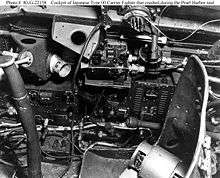
Yanagiya was caught in the tail position by two F4Fs and received bursts of gunfire. The majority of his right hand had been shot off and lost with the top of the control stick with only his little finger remaining attached to his wrist. His right leg had been shot and was bleeding. He thereafter controlled the plane with his left hand and flew back to IJN Munda airstrip at New Georgia Island. During the return flight, with his right leather boot filling with blood from his leg wound and near fainting from the blood loss, he repeatedly shouted in a loud voice to keep himself awake in the cockpit. He was unable to operate levers on the starboard side of the cockpit to unload flaps or landing gears yet he managed to safely make a slide landing into the airstrip. Imperial Japanese Marine soldiers took him out of the cockpit and a doctor operated immediately, cutting the remainder of his right hand off at the wrist.
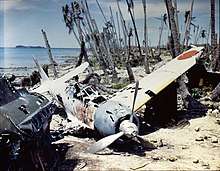
Chief Petty Officer Yoshimi Hidaka and Petty Officer 1st Class Yasushi Okazaki both died in the action. Petty Officer 2nd Class Kameji Yamane was missing in the action. Petty Officer 2nd Class Kenji Yanagiya lost his right hand and was hospitalized. These four pilots all flew Zero fighters armed with heavy bombs beneath each wing on the mission that day. They couldn't fight with all their strength. The Zeros of the 204th Air Group claimed 13 Allied aircraft shot down that day.
On June 16, a Japanese scout aircraft found big group of Allied transports off shore Lunga point, Guadalcanal. The 204th Air Group at Buin base all attacked in full power. The 204th Air Group fighter squadron leader Lieutenant Zenjiro Miyano and Lieutenant (JG) Morisaki died in the action.
On July 1, the remaining 204th Air Group struck the Allied anchorage at Rendova Island. Chief Petty Officer Toyomitsu Tsujinoue was on the duty to escort dive-bombers and missing in the action.
Young Flyer 1st Class Shoichi Sugita kept fighting wildly and survived the Battle of Solomon Islands in 1943, but he was killed in action at the age of 20 in April 1945. In August 1943, he was shot down in flames and bailed out. He was seriously injured and returned homeland Japan alive. In March 1944, Petty Officer 2nd Class Sugita came back as a member of the 263rd Air Group at Guam. But the units were seriously damaged by three days of sorties. In June, the 263rd Air Group members were merged with the 201st Air Group (2nd generation) in the Philippines, which was reorganized as the first Kamikaze Corps by the 1st Air Fleet (2nd generation) Commander in Chief, Vice Admiral Takijiro Onishi. Many younger aviators had been ordered to fly Kamikaze sorties daily. Sugita finally threatened the commander of the 201st Air Group, Captain Sakae Yamamoto with his gun to get an order of Kamikaze sorties for him first. He was ordered to come back to Japan again. In January 1945, Petty Officer 1st Class Sugita joined the 301st fighting squadron of the 343rd Air Group. He was finally shot down and killed in action while he flew a Shidenkai (Allied codename George) taking off from Kanoya Airfield in Kyūshū, Japan in April 1945.
Five out of the six fighter pilots died and one was injured.
Captain Ushie Sugimoto died in action on June 12, 1945 in the Philippines. Sugimoto was the commander in chief of the 26th Air Flotilla. He stayed with his ground members and mechanics of the air units to fight as infantry left without support. His flock was reportedly holding a position somewhere in Mount Pinatubo, Philippines, while all chief officers and most commissioned officers of the 1st Air Fleet's air units had already withdrawn to Taiwan. The 26th Air Flotilla was under the command of the 1st Air Fleet, but the units lost all aircraft Kamikaze sorties by January 1945.
Back on October 25, 1944, Vice Admiral Onishi had called all commanders of his Air Flotillas to a mid-night meeting, at IJN Clark Air Base in Philippine. The Commander in Chief of the 1st Air Fleet, Vice Admiral Onishi, had conferred with his high-ranking officials for ideas on how to repel the Allied forces from the Philippines in a tangible way, but there had been few ideas. Onishi had then decided to expand his operation plan "Kamikaze" to all his air units, and had warned them if there were any officers who opposed "Kamikaze" attacks, they should be executed.[4]
The Japanese were prohibited to surrender by their Military code. Few survivors testified that Captain Sugimoto died from starvation, and his last words were, "Eat my flesh and blood, you must survive."
Yanagiya survived the war. He thought the result of the Yamamoto mission was his shame, not the thing to be proud of. He kept silent until a non-fiction writer, Akira Yoshimura interviewed him 30 years later in mid-1970s.
Yanagiya died on Feb. 29, 2008, at his age of 88.
His record
He was credited with 8 victories. In addition, he was credited with 18 shared victories, where fighter pilots were fully credited for 'shared' victories (i.e., if pilots shot down one aircraft, all pilots were credited a victory as 'shared') in IJN Air Force, which based on the world traditional and orthodox standard the Royal Navy, the Royal Air Force (RAF) and the Armée de l'Air (ALA) adopted in World War I, until World War II.[5][6][7] His flight hours were about 500 hours in June 1943.
| Date | ID code of his Zero Fighter | Flight hours | Count | Sub-total | Mission |
|---|---|---|---|---|---|
| Apr.3 (Sat.) | T2-187 | 1:30 | 1 | 1:00 | Unit formation training |
| Apr.7 (Wed.) | T2-129 | 6:00 | 2 (Operation X) | 7:30 | Attack Lunga point, Guadalcanal |
| Apr.7 (Wed.) | T2-129 | 1:00 | 3 | 8:30 | **** |
| Apr.8 (Thur.) | T2-117 | 1:00 | 4 | 9:30 | **** |
| Apr.9 (Fri.) | T2-169 | 2:00 | 5 & 6 | 11:30 | Test flights in high-altitude capability |
| Apr.11(Sun.) | T2-165 | 1:00 | 7 | 12:30 | Unit formation training |
| Apr.12(Mon.) | T2-169 | 6:00 | 8 (Operation Y) | 18:30 | Attack Port Moresby, escorting Rikko unit |
| Apr.14(Wed.) | T2-169 | 5:30 | 9 (Operation Y1) | 24:00 | Attack Rabi(Milne Bay airfield, New Guinea), escorting Rikko unit |
| Apr.18(Sun.) | T2-169 | 2:15 | 10 | 26:15 | Escorting Rikkos (Adm. Yamamoto) |
| Apr.18(Sun.) | T2-169 | 1:45 | 11 | 28:00 | Buin -> Rabaul |
| Count | Flight hours | |
|---|---|---|
| Monthly sub-total | 27 | 65hrs 00mins |
| Total | 493 | 429hrs 40mins |
Notes
- p295, Ugaki, Hiromitsu
- p.215 - p.220, LTJG Tsunoda, Kazuo
- p.426, Koudachi, Naoki
- p215 - p.230, Chapter 4 "Every Corner", Tokko (Kamikaze), Onda, Shigetaka
- p.8, C. Shores, Above the trenches
- p.6, N. L.R. Franks, Above the Lines
- p.87 - p.89 A. Thomas, Royal Navy Aces of World War II
- p.24-p.25, Nishizawa, Naoaki
References
Books
- Yoshimura, Akira (March 1976). "Kaigun Kō Jiken (Navy kō incident)". Monthly Magazine Bungei Shunju, the 135th issue. Tokyo, Japan: Bungei Shunju. - text in Japanese.
- Yoshimura, Akira (June 2007). "Kaigun Kō Jiken (Navy Kō incident, reprinted version)". Kaigun Otsu Jiken, Bunshun Bunko series, (paper backs). Tokyo, Japan: Bungei Shunju. ISBN 978-4-16-716945-9. - text in Japanese, few images.
- Ugaki, Hiromitsu (November 1, 1952). "Yamamoto Gensui no Senshi (The death in action of Admiral Yamamoto), p.291 - p.299". Sen So Roku (The Wartime Diary of Matome Ugaki), First Volume. Tokyo, Japan: Nippon Shuppan Kyodo. - text in Japanese, few images.
- Koudachi, Naoki (Dec 4, 2006). "Chapter 9, Kumo ni shimiru Sikabane, Yamamoto Chokan no Zensen Sisatsu (The Death in the Air, The Admiral Yamamoto's Inspection on the Frontline)". Zerosen Taicho, 204 Ku Hiko Taicho Miyano Zenjiro no Shogai (Zero Fighter 204 A.G. Squadron Leader, Zenjiro Miyano). Tokyo, Japan: Kojin Sha. ISBN 4-7698-1326-0. - text in Japanese, a few images.
- National Institute for Defense Studies(NIDS) War History Section (November 1970 – March 1976). "Daihonei Kaigun Bu, Rengō Kantai No.1 - No.7". Senshi Sousho. Tokyo, Japan: Asagumo Newspaper. ISBN. - text in Japanese.
- Nishizawa, Naoaki (Apr 2, 2002). "Tragedy of April 18, 1943". Jitsuroku Nichibei Dai-kokusen (Document report of the Great Air Combat between Japan vs. U.S.). Tokyo, Japan: Tachikaze shobo. ISBN 4-651-00950-6. - text in Japanese, with images.
- Onda, Shigetaka (Nov 25, 1988). "Chapter 4 Every Corner, p.215 - p.230". Tokko (Kamikaze). Tokyo, Japan: Kodan Sha. ISBN 4-06-204181-2. - text in Japanese, no images.
- The 204th Air Group Fighter Pilots Association (March 10, 1987). "Meian wo waketa 4.18 (The April 18th), p.177 - p.199". Rabaul Kuhsen Ki (The Battle of the Air Rabaul), air combat series, (paper backs). Tokyo, Japan: Asahi Sonorama. ISBN 4-257-17082-4. - reprinted in paper backs of the first printed in June, 1976; text in Japanese, few images.
- Tsunoda, Kazuo (March 17, 2003). "Chapter 3, Rabaul - Shito no Tsubasa (Wings to the Death, P-38 and the Admiral Yamamoto)". Shura no Tsubasa (The Bloody Gardian Angel, Asura's Wings). Tokyo: Kohjin-sha. ISBN 4-7698-1041-5. - reprinted version, text in Japanese, a few images.
- Norman L. R., Franks; Bailey, Frank W. (May 1992). Over the Front: A Complete Record of the Fighter Aces and Units of the United States and French Air Services, 1914-1918. London, Great Britain: Grub Street the Basement. ISBN 978-0-948817-54-0.
- Sakaida, Henry (1998). "NEW GUINIA, RABAUL AND THE SOLOMONS, Warrant Officer Kenji Yanagiya p.44 - p.45". Imperial Japanese Navy Aces 1937-45. London, Great Britain: Ospray. ISBN 1-85532-727-9.
- Shores, Christopher; Franks, Norman; Guest, Russell (Jan 1991). Above the Trenches: A Complete Record of the Fighter Aces and Units of the British Empire Air Forces, 1915-1920. London, Great Britain: Grub Street the Basement. ISBN 978-0-948817-19-9.
- Stanaway, John (1997). "THE YAMAMOTO MISSION, p.14 - p.17". P-38 Lightning Aces of the Pacific and CBI. London, Great Britain: Ospray. ISBN 1-85532-633-7.
- Tagaya, Osamu (1988). "RECRUITMENT AND TRAINING, P.10, P.12". Warrior 55, Imperial Japanese Naval Aviator 1937-45. United Kingdom: Ospray. ISBN 1-84176-385-3.
- Thomas, Andrew (March 27, 2007). "APPENDICES, Royal Navy Aces". Royal Navy Aces of World War 2. United Kingdom: Ospray. ISBN 978-1-84603-178-6.